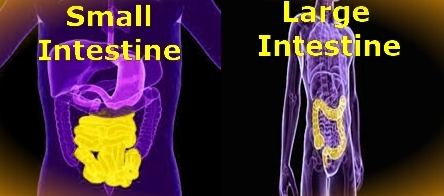Difference between Small and Large Intestine

Difference between Small and Large Intestine
Intestines are long tubular structures present in animals and humans which serve not only excretory function but also absorb water and nutrients. Intestines start from the end of stomach and end at anus. It is divided into small and large intestines. Their length is in meters and they are folded upon themselves in order to get adjust into the abdominal cavity. Their main support is mesentery which is a thin membrane attaching them to the back of abdomen. Blood vessels carrying blood to the intestine and away from them are also present in this mesentery.
Small Intestines
Small intestine is the longest part of GIT which starts at the end of stomach and runs up to the large intestine. Its first part is duodenum which receives digested food from stomach and along with further digestion, it absorbs some nutrients. Food is then passed to jejunum which is the main site for absorption. Lastly, the food enters the ileum which further absorbs the remaining nutrients.
Large Intestine
Large intestine is divided into cecum, colon and rectum. Food from the ileum enters the cecum which provides attachment to the appendix. Fecal material is the carried from cecum to the ascending colon, from there it passes to transverse colon and then descending colon and then finally to the rectum where they are stored for short period and then excreted out of body through relaxation of sphincters at the end of anal canal.
Small Intestine Vs Large Intestine
Route:
Small intestine starts at the end of stomach and goes up to the cecum.
Large intestine starts at cecum and end at rectum.
Length:
Small intestine is 10 feet in length.
Large intestine is 5 feet in length.
Diameter:
Small intestine is 1 inch in diameter.
Large intestine is 2 and a half inch in diameter.
Parts:
Small intestine is divided into duodenum, jejunum and ileum.
Large intestine is divided into cecum, colon, rectum and anus.
Function:
Small intestine is more specific to absorb nutrients.
Large intestine mainly absorbs water from the digested food.
Location:
Small intestine is located in the central part of abdomen.
Large abdomen has got peripheral location.
Structure:
In small intestine, valvulae conniventis are present which circular folds in the intestine.
Large intestine has similarly got haustrations which are also folds but do not run along the entire width of lumen of intestine.
Villi:
Villi are long brush like structures at the end of cells of intestine which are present in small intestine.
Villi are absent in large intestine.
Peyer’s patches:
Peyer’s patches are aggregates of lymphoid cells present in small intestine.
These are absent in large intestine.
Role in digestion:
Small intestine further digests food material obtained from stomach.
Large intestine is not involved in digestion rather absorption only.
Pain:
Pain of small intestine is central in location and diffuse in characteristic.
Pain of large intestine is peripheral and colicky.
Conclusion
Intestines are the vital organs which are parts of digestive system of human body and excrete the waste material through body along with absorption of nutrients which are important for survival.


Leave a Reply